
Dick De Jong
February 12, 2009
HDTV Solutions
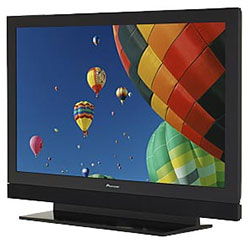
Pioneer has rightfully earned a reputation for producing big beautiful plasma HDTVs. The picture quality of their KURO brand is considered by many videophiles as the gold standard to which all other TVs are compared.
The gorgeous images emanating from the KURO PDP-6020FD do not disappoint. And to cut to the chase, we are bestowing on this 60 inch 1080p plasma our Highly Recommended rating.
Of course, not surprisingly, acquiring an upper echelon HDTV of this size requires a chunk of change. Think of the purchase as your personal patriotic contribution to the economic stimulus plan.
(In addition, Pioneer produces a 50" KURO, the PDP-5020FD, which has similar specifications to its bigger brother. This review can be applied to it also.
Please be aware that Pioneer also makes another model in the KURO line called the Elite. Though their performance is similar to the non Elites, these more expensive plasmas, like the 60" PRO-151FD, offer more features.)
(Editor's Note: As I write this review, I mourn the news that Pioneer is exiting the TV business by March 2010. Their leadership in pushing the technological boundaries will be sorely missed.)
Now if you wish to explore some of the other features like the Home Media Gallery, you will have to do a little more digging through the manual, which is, thankfully, well-written.
The question is, does the performance of this KURO represent value for this price? I say, yes. As always, ultimately, you are the one that will have to answer that question.
Before you can admire the PDP-6020FD, you are faced with the Herculean task of pulling this five foot wide, 112 pound behemoth out of its box and attaching it to its stand.
As part of the construction project, the stand's metal supports are bolted into the TV and then the separate speaker system is hung in between the base and the screen. Once assembled, at over 131 pounds, the whole system is heavier than a Super Featherweight boxer.
Even with hand grips molded into the back of the TV, manhandling this monster is not a walk in the park and is best left to professionals. I figure that if you are spending the dough on the TV, you might as well trickle down some bread to a pair of muscular installers.
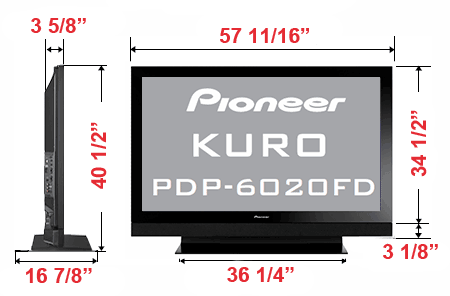
When you are planning where to locate this double-wide trailer of a TV, remember that the area of this 60" screen (1515 square inches) is over twice that of a typical 42" model (755 square inches). The PDP-6020FD is a big TV that you just can't plop down willy-nilly - at least not if you wish to keep the aesthetically sensitive souls in the household contented.
The only notable aspect to the exterior's design is the wider than usual (two and three quarters inch) piano black bezel. Other than that, the front of the speaker bar is covered in a traditional matte black fabric.
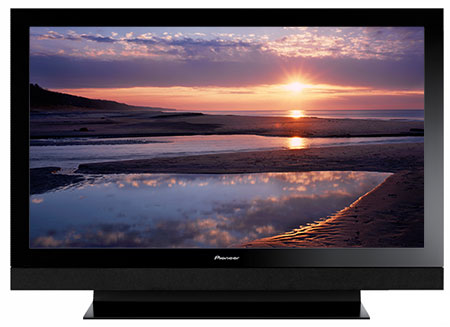
In the past, high reflectivity has been a bugaboo for plasma screens, as a group. I feel that in the last few years, technology like this KURO's anti-reflective filter has put those concerns to rest. I will not deny that bright lights will reflect in the screen, but it's only noticeable when the TV is turned off.

The upside to plasmas is their truly wide viewing angle. You can seat your party of March Madness maniacs all around this KURO and they won't notice a fall off in picture quality. Which is good because the HDTV does not swivel on its stand.
On the left edge of the frame is a convenience panel that contains the TV control buttons alongside of an HDMI input, a Composite In (with a stereo Audio In), a headphone mini-jack Out, and a USB port for accessing photo, music or video files to play on the TV.
On the back this HDTV - way back in the center - is the main connection panel. Unless you have the wingspan of the 7' 6" Yao Ming, reaching around this KURO to plug in cables is not easy. If you can, try to do all your connecting when you have clear access to the rear of the TV.
This panel contains three more HDMIs. The two HDMIs on the left, Inputs 4 and 5, can be paired with one of the stereo analog Audio Ins. In addition, there's one Component In (Y,Pb/Cb,Pr/Cr) with a stereo Audio In, two Composite Ins (with stereo Audio Ins), one S-Video In, one VGA PC input with an Audio In (stereo mini-jack) and a Service Port.
Since the speakers are not integrated into the system, they need to be wired up to the speaker terminals on the panel.
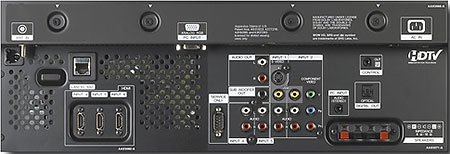
For routing audio out to a separate receiver, this Pioneer provides one stereo analog Audio Out, and one digital Audio Out (optical). It also supplies a Subwoofer Out that you can connect directly to the subwoofer.
The one RF antenna connector links to integrated NTSC/ATSC/QAM tuners. Since the tuner system is Clear QAM compatible, you can attach your cable TV signal directly into the RF connector and tune in unscrambled cable stations.
For those concerned about the DTV transition coming up, the ATSC tuner is the key. With the proper antenna, you will be able to tune in digital signals broadcast over the air.
The Ethernet port on the panel allows you to connect to your home network. If you set up a media server, you can access high resolution photos, music, and videos directly from the server to play on the KURO.
This Pioneer is not one of the new breed of TVs that contains software that allows you to stream content directly from the Internet without a computer intermediary.
What the PDP-6020FD does furnish is one of the most robust photo/music/video interfaces that I have seen on a TV. From this Home Media Gallery, users can easily access and enjoy their high-definition photos, music and movies either through the USB connection or the Ethernet port.
You can make Playlists of photos, videos and music. I like that the Gallery is compatible with a wider range of formats beyond just JPEGs, (PNG, GIF, TIFF, BMP). Slideshows can be customized with various slide durations and transitions.
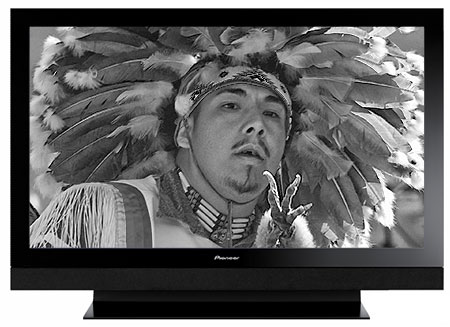
I love that you have separate Picture controls for the Home Media Gallery so you can tweak how your photos will display. You can't imagine the majesty of viewing your images on a 60" plasma. And for those wannabe classic photographers, click on the Monochrome option and all of your slides will be projected in black & white.

If I were to niggle, the transitions between slides are slow and not smooth. Don't expect the capability to display a professional seamless slideshow.
The PDP-6020FD offers good picture-in-picture and picture-on-picture features. On a 60" screen, side by side PIP images are almost like watching two 32" TVs.
The remote control is square, man. With a staid brushed black surface and an all right angled design, the remote is strictly business. Though if you occasionally expose it to sunlight, it will glow a soft luminous blue -green in the dark. When programmed, it can operate multiple devices.
I applaud the dedicated buttons for selecting various video sources, but I would prefer that they were labeled more specifically (for example, HDMI1) than simply 1 through 7. I found the Tools key to be a helpful shortcut to some of the more common tasks.
The EPA is now publishing a list of ENERGY STAR qualified TVs. (You can find it here.) The Pioneer PDP-6020FD is on the list.

The EPA states that this KURO's On Mode Power is 355.6W and Standby Power Consumption is .21W. Based on the formula that the TV is on five hours a day and in Standby for the other 19, the Estimated Annual Energy Use is 650 kWh/year.
You need to check your electric bill to see how much you are paying for a kWh. The national average is 10.4 cents. Doing the multiplication, at that rate, the yearly energy cost is $68.90.
When we measured power consumption using a watt meter, called Watts up? Pro, as we expected, the readings varied depending on the Picture Mode that we chose. If at all possible, I recommend that you avoid the more power gobbling modes like Performance, Dynamic and Sport.
Pioneer also furnishes an Energy Save option, which as the manual states, "decreases picture brightness and lowers power consumption. The recommended setting, Energy Save Mode 1, extends the life of your panel while keeping power usage at a minimum."
To calibrate the TV, we use the Blu-ray version of the Digital Video Essentials DVD called HD Basics. We are playing the DVD on a Sony BDP-S350 Blu-ray player connected to the HDTV with an HDMI cable.
We use the test patterns to adjust black level, white level, and color bias. The player is set to output a 1080p signal, which is the native resolution of the PDP-6020FD.
For all the video processing brawn built into this KURO, I was surprised by the lack of picture controls. I found that I had to alter my usual setup routine because some of the old standby settings like Color Temperature are not to be found.
To begin, I quickly sampled the Picture Modes: Performance, Dynamic, Sport, Standard, Movie, Game and Optimum. Pioneer spokesperson, Christina Ramirez noted, "Movie is the preferred picture mode chosen by our engineers for being the most accurate and is also the one recommended for those with discerning entertainment tastes." Since I planned on customizing my settings, I chose Standard.
Next, I normally find the Color Temperature control, but as I said, it's not there. The default color temperature of Standard leans towards cool blue. If you prefer a warmer default, then pick Movie mode to tweak.
In my usual routine, I open up the Advanced Video menu and turn Off all the features like Adaptive Luma. Alas, there is no Advanced Video menu on this Pioneer. About the only semi-advanced control that I could discover was the Room Light Sensor. You may want to turn it off when you are performing your initial adjustments and then activate it afterward.
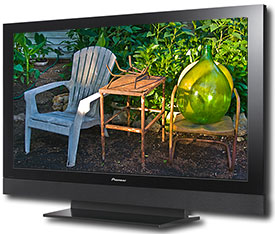
So I returned to the one and only Picture menu where I adjusted Brightness up a few notches from the midpoint of 0. Contrast was dialed to 36.
The test patterns indicated that Color (Saturation) should be around +14 and Tint (Hue) at 5 towards Green. When I watched real world video, the picture was just too saturated, therefore I turned back Color to no more than +7. Though with some programs, 0 seemed more appropriate.
The Sharpness slider runs from -15 to +15. At any setting higher than -10, fringing became too noticeable.
Since those five controls were the only ones provided, I was finished running through the test patterns in less than fifteen minutes. The bottom line is that the image looked great.
Obviously, a lot of video processing is going on behind the curtain. For me, I'm perfectly satisfied to let the great and powerful Wizard perform his video magic without me twiddling around with the knobs.
Now, as I began to read the manual and to explore different features, I revisited the Optimum picture mode, which I initially pooh-poohed as a gimmick setting like the overcharged Dynamic. Boy, was I wrong.
The manual states that Optimum "Automatically analyzes and adjusts audio and video settings according to specific room light conditions and type of light and color. Program content is also monitored and finely adjusted so movies, sports and news are all faithfully reproduced."
I have never been a big fan of auto adjustment features, but Optimum works. I was watching the super saturated Speed Racer with the TV set to my customized Standard mode settings. The picture looked good but a little too frothy, even when I turned Color down. I switched to Optimum and the image retained its richness without the extra foam.
I put in other, less over the top, Blu-rays and HD-DVDs and the difference between my settings and Optimum were not as pronounced. In almost every instance I preferred Optimum, though occasionally it cranked up the Contrast and Brightness beyond my taste.
For our edification, Pioneer has added a spiffy feature to illustrate what Optimum is adjusting. If you hold down the Display key, an overlay screen pops up that dynamically tracks the moment to moment changes on factors like Brightness and Contrast.
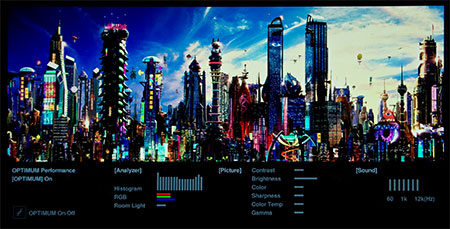
If you look closely at the bottom of the list, you see Optimum is also tweaking Color Temperature and Gamma. No wonder it looks so good.
One last point about Optimum, you can tell it to also adjust the Sound. In this case, I would turn that option off. I liked the quality of the audio better with the changes I made in the Audio menu.
Finally, Pioneer has posted on their website an update to the PDP-6020FD's firmware. It was a straightforward procedure to download the folder, unzip it, transfer it onto a USB drive and install it on the TV.
Plasmas have always outshined LCDs because of their ability to produce deep blacks. The theory is, the deeper the blacks, the richer the colors. And Pioneer KUROs are considered among the leaders in darkness - the Sith Lords of HDTVs.
This deep black notion may seem like an abstract theory, but when you see the reality on a five foot screen, you'll become a convert. When you experience those eye popping scenes, you know that you have died and gone to HD heaven.
But what moves me most are those stealth moments when you are caught up in the movie and slowly a sensation starts snaking up your spine and then you quietly realize how divine the picture looks. It's transcendent.
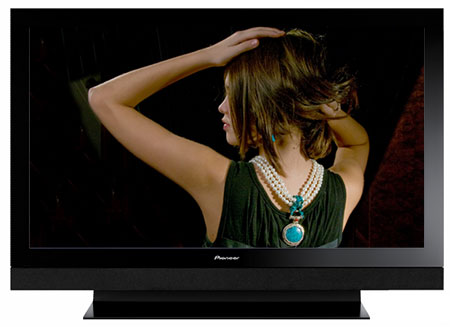
As a side benefit for those who like to watch their favorite movies again and again, viewing them on a display as big as the 60" PDP-6020FD gives you the ability to see details that may not be evident on a smaller TV. For example, I found myself watching the expressions on actors in the background of a scene.
I decided not to connect my laptop to the TV with a VGA cable because the manual stated that this connection was only capable of a 1360 x 768 resolution. I know it would look fine, but what a waste of pixels. If you plan on hooking your computer directly to the KURO, use an HDMI cable or a DVI to HDMI.
The audio output from the 18W detachable speakers is as good as I have heard from a TV's audio system. I actually feel comfortable about describing it with terms like separation and presence. I even had a musician in who praised the audio quality.
The Audio menu only provides the basic Treble, Bass, and Balance controls. But the Sound Effect submenu furnishes four additional features from the audio company SRS: SRS FOCUS, SRS, SRS TruBass and SRS Definition. I set each at Mid except for Definition, which "clarifies voice and instrument sound." I dialed it to High.
The effects definitely improved the tone and texture of the audio. With that said, if you are planning a home theater setup, seriously consider a dedicated 5.1 sound system.
The Pioneer KURO PDP-6020FD is simply one big beautiful plasma with outstanding picture quality that earns this HDTV our Highly Recommended rating.
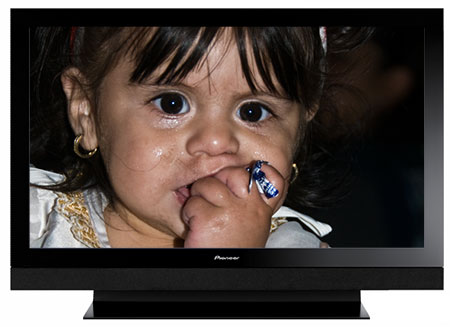
Posted Apr 13, 2017 12:25:34 PM
By Ron Kunkel